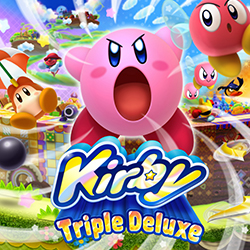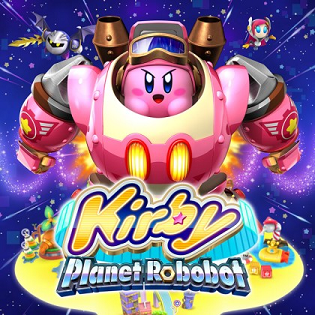
Kirby is the titular character and protagonist of the Kirby series of video games owned by Nintendo and HAL Laboratory. He first appeared in Kirby's Dream Land (1992), a platform game for the Game Boy. Since then, Kirby has appeared in over 50 games, ranging from action platformers to puzzle, racing, and even pinball, and has been featured as a playable character in every installment of the Super Smash Bros. series (1999–present). He has also starred in his own anime and manga series. Since 1999, he has been voiced by Makiko Ohmoto.

Sonic Advance, known as SonicN on the N-Gage, is a 2001 platform game developed by Dimps and published by Sega for the Game Boy Advance. It was the first Sonic the Hedgehog game released on a Nintendo console with Sonic Adventure 2: Battle on the GameCube, and was produced in commemoration of the series' tenth anniversary. The story follows Sonic, Tails, Knuckles, and Amy as they journey to stop Doctor Eggman from taking over the world. Controlling a character, players are tasked with completing each level, defeating Eggman and his robot army, and collecting the seven Chaos Emeralds.

Kirby's Dream Land is a 1992 platform video game developed by HAL Laboratory and published by Nintendo for the Game Boy. It is the first game in the Kirby series and marks the debut of Kirby. It introduced many conventions that would appear in later games in the series. The game follows Kirby as he goes through five levels to retrieve the Sparkling Stars and food of Dream Land from King Dedede.

Kirby's Adventure is a 1993 platform game developed by HAL Laboratory and published by Nintendo for the Nintendo Entertainment System (NES). It is the second game in the Kirby series after Kirby's Dream Land (1992) on the Game Boy and the first to include the Copy Ability, which allows the main character Kirby to gain new powers by eating certain enemies. The game centers around Kirby traveling across Dream Land to repair the Star Rod after King Dedede breaks it apart and gives the pieces to his minions.

Kirby Super Star, released as Kirby's Fun Pak in PAL regions, is an anthology platform video game developed by HAL Laboratory and published by Nintendo for the Super Nintendo Entertainment System in 1996. It is part of the Kirby series of video games by HAL Laboratory. The game was advertised as a compilation featuring eight games: seven short subsections with the same basic gameplay, and two minigames.

Kirby's Dream Land 2 is a side-scrolling platforming video game developed by HAL Laboratory and published by Nintendo for the Game Boy handheld video game console. It was released in Japan on March 21, 1995, in North America on May 1, 1995, in Europe on July 31, 1995, and in Australia on November 22, 1995.

Meta Knight is a fictional character and antihero in Nintendo's Kirby video game series created by Masahiro Sakurai and developed by HAL Laboratory. He first appeared in the 1993 video game Kirby's Adventure as a nameless character, remaining unnamed until the game Kirby's Avalanche. The character also appears in several Kirby comic books, in the 2001 anime series, and as a playable character in the Super Smash Bros. series.

Kirby’s Block Ball, known in Japan as Kirby no Block Ball, is a 1995 video game developed by Tose and Nintendo and published by Nintendo for the Game Boy portable console. It is a spin-off of the Kirby video game series. It is a Breakout clone; the player controls paddles along the screen's edge to knock a bouncing ball, Kirby, into destructible bricks. The game's 55 levels include power-ups, bonus rounds, and minigames. The team spent half a year revising the gameplay to match Kirby's signature characteristics. Kirby's Block Ball was released in Japan on December 14, 1995, later in North America on May 13, 1996 and finally in Europe on August 29, 1996.

Kirby: Squeak Squad, known in Europe as Kirby: Mouse Attack, is a platform video game developed by HAL Laboratory and Flagship and published by Nintendo for the Nintendo DS. It is one of the mainline installment entries of the Kirby series and the second Kirby game released for the system. The game was released in Japan and North America in 2006 and in Europe, Australia, and South Korea in 2007. The game was later re-released for the Wii U's Virtual Console on June 25, 2015.
This is a list of characters from the Kirby franchise, who are featured in video games and other media across the franchise.

Kirby is an action-platform video game series developed by HAL Laboratory and published by Nintendo. The series centers around the adventures of a bubblegum pink round hero named Kirby as he fights to protect and save his home on the distant Planet Popstar from a variety of threats. The majority of the games in the series are side-scrolling platformers with puzzle-solving and beat 'em up elements. Kirby has the ability to inhale enemies and objects into his mouth, spitting them out as a projectile or eating them. If he inhales certain enemies, he can gain the powers or properties of that enemy manifesting as a new weapon or power-up called a Copy Ability. The series is intended to be easy to pick up and play even for people unfamiliar with action games, while at the same time offering additional challenge and depth for more experienced players to come back to.

Kirby Super Star Ultra is an anthology platform video game developed by HAL Laboratory and published by Nintendo for the Nintendo DS in 2008. The game is an enhanced remake of Kirby Super Star, originally released for the Super Nintendo Entertainment System in 1996, to commemorate the Kirby series' 15th anniversary. The remake retains all game modes found in the original, and adds four major new ones, along with adding updated visuals and full-motion video cutscenes.

Kirby's Epic Yarn is a platform game developed by Good-Feel and published by Nintendo for the Wii. It is an installment of the Kirby series and was released in October 2010 in Japan and North America and in February 2011 in Australia and Europe. It is the first entry in the Kirby series on a home video game console since 2003's Kirby Air Ride for the GameCube, and its first home console platform game since 2000's Kirby 64: The Crystal Shards for the Nintendo 64.

Kirby: Triple Deluxe is the thirteenth platform and tenth mainline installment of the Kirby video game series, developed by HAL Laboratory and published by Nintendo for the Nintendo 3DS. The game was released in Japan on January 11, 2014, in North America on May 2, 2014, in Europe on May 16, 2014, and in Australia on May 17, 2014. The game follows Kirby as he embarks on a journey through six worlds to rescue King Dedede from Taranza.

Kirby: Planet Robobot is a 2016 platform game developed by HAL Laboratory and published by Nintendo for the Nintendo 3DS. It is the eleventh mainline installment in the Kirby series and the spiritual sequel to Triple Deluxe. The story follows Kirby as he defends Planet Popstar from an alien corporation known as the Haltmann Works Company that wishes to mechanize the planet so that they can plunder its natural resources. New to the series in this game is Kirby's ability to utilize a mecha suit known as the Robobot Armor to solve puzzles and fight enemies.

Kirby Star Allies is a 2018 platform video game developed by HAL Laboratory and published by Nintendo for the Nintendo Switch. It is the twelfth mainline installment in the Kirby series, the player controls Kirby in his quest to prevent a priest named Hyness from reviving a dark force to destroy the universe. Kirby must complete each level by jumping, inhaling enemies, and using his array of abilities to progress.

Kirby Battle Royale is a brawler multiplayer video game in the Kirby series. Developed by HAL Laboratory and published by Nintendo, the game was released on the Nintendo 3DS handheld game console in Europe and Japan in November 2017, and in North America in January 2018.

BoxBoy! is a series of puzzle-platform games developed by HAL Laboratory and published by Nintendo. The series centres around Qbby, a square-shaped character who can produce a string of connected boxes. The boxes are used to overcome obstacles in stages that Qbby must be guided through. The first game, BoxBoy!, released on January 14, 2015, in Japan on the Nintendo 3DS. Its sequel, BoxBoxBoy!, was released for the Nintendo 3DS in 2016, with a third game, Bye-Bye BoxBoy!, in 2017. A physical compilation of the first three games, HakoBoy! Hakozume Box, was released in Japan. A fourth installment, BoxBoy! + BoxGirl!, was released for the Nintendo Switch in April 2019.


















